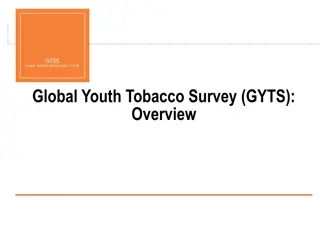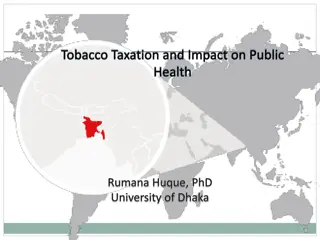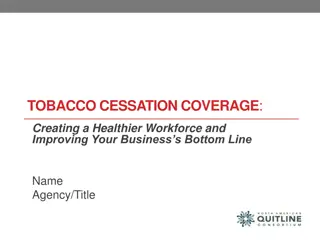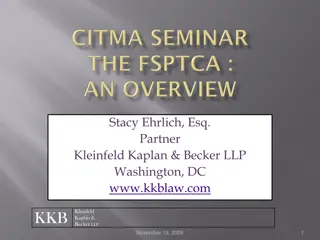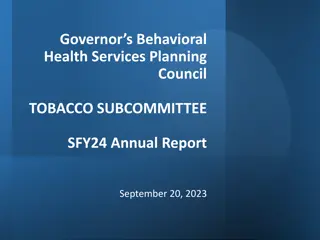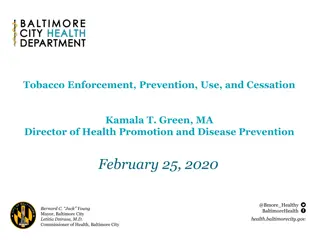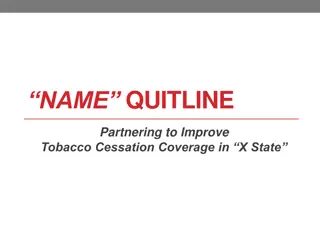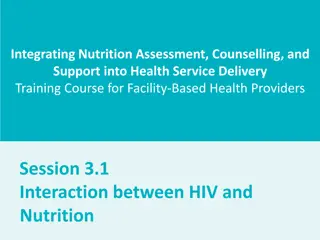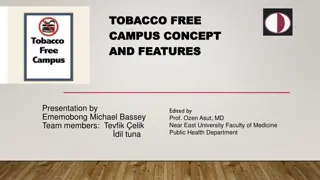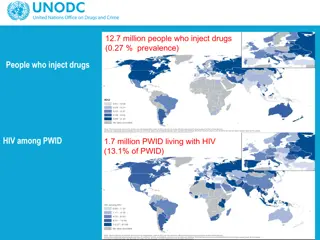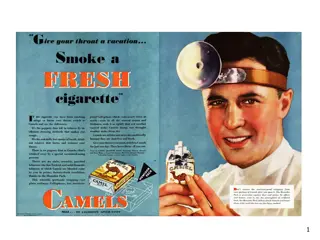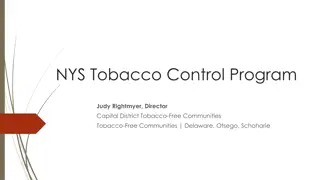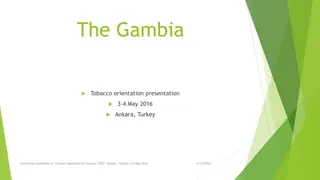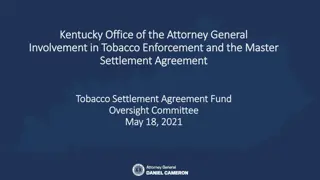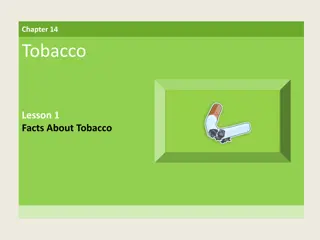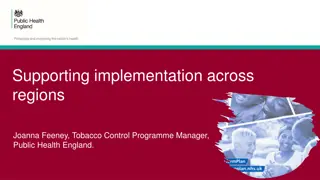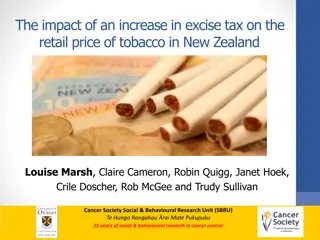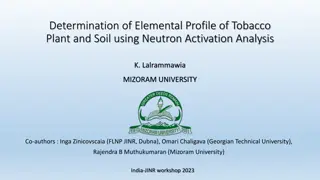Tobacco Reduction in People Living with HIV: Challenges and Solutions
Tobacco use among people living with HIV (PLWH) in Michigan poses a significant health risk, leading to preventable deaths and severe health consequences. The data highlights the high prevalence of smoking among different populations disproportionately impacted by tobacco use. Smoking cigarettes can worsen HIV progression and increase medication complications, weakening the immune system. Despite the desire to quit, PLWH encounter barriers to tobacco cessation that require ongoing treatment and support.
Download Presentation

Please find below an Image/Link to download the presentation.
The content on the website is provided AS IS for your information and personal use only. It may not be sold, licensed, or shared on other websites without obtaining consent from the author. Download presentation by click this link. If you encounter any issues during the download, it is possible that the publisher has removed the file from their server.
E N D
Presentation Transcript
Tobacco Reduction in People Living with HIV Lynne Stauff, MPA Tobacco Section Michigan Department of Health and Human Services
Causes of Preventable Death State of Michigan, 2016 Cigarettes 17,293 Secondhand Smoke 1,740 Drug Overdose 1,338 Suicide 1,296 Auto Accidents 1,047 Tobacco kills more people in Michigan * than AIDS, alcohol, auto accidents, cocaine, heroin, murders and suicides - combined. Alcohol 879 Homicide 634 AIDS 125 Opioid Overdose 472 0 2000 4000 6000 8000 10000 12000 14000 16000 18000 20000
Tobacco Dependence IS a Chronic Disease Similar to diabetes, heart failure, hypertension, hyperlipidemia Expectation for remission and relapse Provide ongoing treatment: advice/counseling support appropriate pharmacotherapy 3
Tobacco Dependence: A Chronic Disease There is a spectrum of disease severity Effective treatments are available High dose and multi-drug regimens may be necessary to achieve the target goals May require referral to specialists Individualized therapy is important 4
Adult Current Smoking Rates by Populations Disproportionately Impacted by Tobacco Use in Michigan, 2015 Behavioral Risk Factor Survey. 50% HIV-positive person* 46.8% Low SES State Average = 20.7% 43.8% Native American 38% With poor Mental Health 35.9% LGBT 34.9% Uninsured 32.6% Arab American ** 27% With disability 25.9% African American 0% 10% 20% 30% 40% 50% 60% * HIV Client Survey 2015 ** Arab & Chaldean American Survey 2009
Effects of smoking cigarettes on PLWH Quicker progression to HIV Stage 3 Interferes with liver s processing of medications Increases the likelihood of complications from medications Weakens the immune system On average HIV clients die 12.5 years soon from Tobacco use Image courtesy of DC Tobacco Free Coalition
PLWH smokers want to quit 72% of HIV positive smokers have tried to quit 63% are currently thinking of quitting
Barriers to Tobacco Cessation in PLWH Lack of knowledge of impact on disease status and medications Smoking status not asked Minimal tobacco treatment expertise https://encrypted-tbn0.gstatic.com/images?q=tbn:ANd9GcQSbdjFBLskoon6Djg2FWt8-2lLPSxrz_Iwjp50ZVnJUwb1Lo_CP1NZwIqz Co-morbidity psychiatric illness & substance use disorder Tobacco industry policy
Organizations Providing Tobacco Reduction Services For PLWH FY 2018 Tobacco Reduction Project in PLWHA- 4thFY (2018) Michigan Map showing the 16 funded ASOs and the 5 LGBT organizations
Goals & Objectives Goals Long term Improve health outcomes for PLWH Mid term - Increase the # of tobacco quit attempts for PLWH Short term - ASOs use tobacco clinical practice guidelines when creating tobacco dependence treatment (TDT) policy and process Objectives/Activities Educate and train ASO staff on tobacco as a priority and treatment resources Improve data (HIV client and ASO staff) Document TDT activities through CAREWare Create expertise in ASOs trained Tobacco Treatment Specialists Educate and use Motivational Interviewing for behavior change 10
Project Accomplishments 2015 Added all cessation medications to ADAP formulary Modified CAREWare to capture treatment conducted Base line survey of ASO staff knowledge, attitudes and behaviors (KAB) 108=n Base line data of clients KAB, n=1,500 Held 14 focus groups with 92 tobacco users with HIV Focus Group Report 2016 Trained 32 ASO staff as Tobacco Treatment Specialist and Certified Interventions conducted
I Will Quit Project Accomplishment
Resources HIV & Tobacco Specific HIV Guide for Clinical Care, April 2014, Pgs. 189-196 http://hab.hrsa.gov/deliverhivHIV Stage 3care/2014guide.pdf HIV Provider Smoking Cessation Handbook, produced by the Veterans Administration http://www.va.gov/vhapublications/ViewPublication.asp?pub_ID=2826, July 2012 HIV & Tobacco Use: Pharmacologic and Behavioral Methods to Help your Patients Quit, Mountain Plains AETC, March 2014 http://www.mpaetc.org/MPAETC/media/MPAETC/Product%20Downloads/tobacco.pdf HIV and Smoking Resources at HIV Stage 3.gov http://www.HIV Stage 3.gov/hiv-HIV Stage 3- basics/staying-healthy-with-hiv-HIV Stage 3/taking-care-of-yourself/smoking-tobacco-use/ Youtube video: Conversations with HIV Stage 3.gov : https://www.youtube.com/watch?v=KyRcGSx1T1s&feature=player_embedded YouTube video: Brian s Story Tips from a Former Smoker who is living with HIV - http://www.cdc.gov/tobacco/campaign/tips/resources/videos/brian-videos.html
Resources for Providers Tobacco Resources for Providers Tobacco Use and Dependence Treatment, 2009: A Quick Reference for Clinicians https://health.state.us/Downloads/TQL_Quick%20Reference.pdf American Academy of Family Physicians Ask and Act, http://www.aafp.org/patient- care/public-health/tobacco-cessation/ask-act.html Michigan Providers Tobacco Cessation Tool Kit: http://www.michigancancer.org/Resources/TobaccoPV.html University of Wisconsin Center for Tobacco Research & Intervention offers videos and other tobacco training materials at www.ctri.wisc.edu CDC Tips Campaign from former smokers: http://www.cdc.gov/tobacco/campaign/tips/partners/health/hcp/ Tobacco Free Toolkit for Community Health Facilities - http://bhwellness.org/wp- content/uploads/2011/04/Tobacco%20Free%20Facilities%20Toolkit.pdf Robbing the Future, Office of the Surgeon General youtube video: http://www.youtube.com/watch?v=5Wlob8oCuQ8&feature=youtu.be Five Major Steps to Intervention (The 5A s ): http://www.ahrq.gov/sites/default/files/wysiwyg/professionals/clinicians- providers/guidelines-recommendations/tobacco/5steps.pdf
Resources for Clients Michigan Tobacco QuitLine, 1-800-784-8660 or 1-800-QUITNOW, https://michigan.quitlogix.org My Smoking Cessation Handbook, Veterans Administration materials: http://www.va.gov/vhapublications/ViewPublication.asp?pub_ID=2827 U.S. Public Health Service offers a free booklet, You Can Quit Smoking Now! Call 1-800- QUITNOW, The Health Consequences of Smoking 50 Years of Progress: A Report of the Surgeon General, 2014 | SurgeonGeneral.gov American Cancer Society offers printed material and sponsors the Great American Smokeout on the third Thursday in November. Call 1-800-227-2345. www.cancer.org American Heart Association offers printed material. Call 1-800-242-8721. www.americanheart.org American Lung Association offers quit smoking classes, printed material, cessation website. Call 1-800-586-4872. Telephone referral and cessation advice is available by calling 1-866-784-8937. www.lungusa.org National Cancer Institute offers a quit kit and telephone advice at 1-877-44U-QUIT. http://www.cancer.gov/about-cancer/causes-prevention/risk/tobacco Nicotine Anonymous at 415-750-0328. www.nicotine-anonymous.org QuitNet Online Smoking Cessation, www.quitnet.com BecomeanEX: A website offering an online quit smoking program. www.becomeanex.org
Thank You! Questions, Comments, Reactions Lynne Stauff StauffL@Michigan.gov


